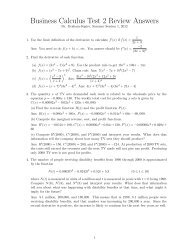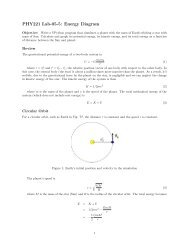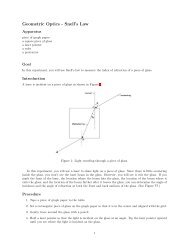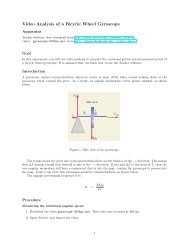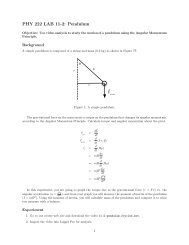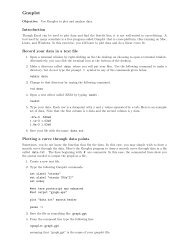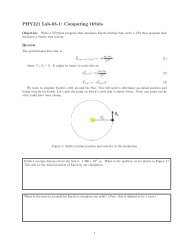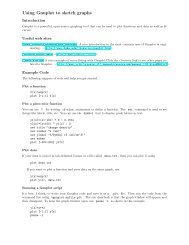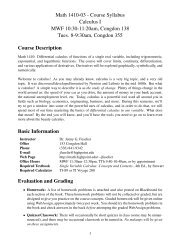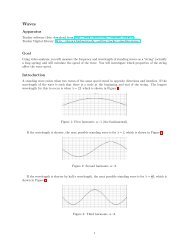Physics 1520, Fall 2011
Physics 1520, Fall 2011
Physics 1520, Fall 2011
You also want an ePaper? Increase the reach of your titles
YUMPU automatically turns print PDFs into web optimized ePapers that Google loves.
<strong>Physics</strong> <strong>1520</strong>, <strong>Fall</strong> <strong>2011</strong><br />
Quiz 1, Form: A<br />
Name:<br />
Date:<br />
Numeric answers must include units. Sketches must be labeled.<br />
Section 1.<br />
Multiple Choice<br />
1. In the lab, you set up a vertical mass-spring system. You pull the mass down and release it from rest.<br />
It oscillates with a period of 2.0 s. What is its frequency<br />
(a)<br />
(b)<br />
(c)<br />
(d)<br />
(e)<br />
π Hz<br />
0.25 Hz<br />
0.5 Hz<br />
2.0 Hz<br />
4.0 Hz<br />
Questions 2–4: A simple harmonic oscillator has the x(t) graph shown below.<br />
2. What is the period<br />
(a) 1.2 s<br />
(b) 2.0 s<br />
(c) 1.7 s<br />
(d) 4.0 s<br />
(e) 2.2 s<br />
3. What is the amplitude<br />
(a) -10 cm<br />
(b) 2.5 cm<br />
(c) 5 cm<br />
(d) 10 cm<br />
(e) 20 cm<br />
4. What is the first clock reading t when the velocity of the object is zero<br />
(a) 0.2 s<br />
(b) 1.7 s<br />
(c) 0<br />
(d) 1.2 s<br />
(e) 0.7 s<br />
1
5. Four different oscillators are shown below.<br />
Which oscillator has the greatest angular frequency ω<br />
(a)<br />
(b)<br />
(c)<br />
(d)<br />
(e)<br />
A<br />
B<br />
C<br />
D<br />
They have the same angular frequency.<br />
6. A bullwhip is thick at the handle and thin at the end. Thus, its linear density µ is larger at the handle<br />
and smaller at the end. As a wave pulse travels down the whip, its speed v will<br />
(a)<br />
(b)<br />
(c)<br />
decrease<br />
increase<br />
stay the same<br />
7. Blue light has a shorter wavelength than red light. Which color as a higher frequency<br />
(a)<br />
(b)<br />
(c)<br />
blue<br />
red<br />
neither, because they have the same frequency<br />
8. What determines the speed of a wave in a medium<br />
(a)<br />
(b)<br />
(c)<br />
(d)<br />
(e)<br />
the frequency of the wave<br />
the wavelength of the wave<br />
the amplitude of the wave<br />
the power of the wave<br />
the properties of the medium<br />
9. In a class demo, the speaker emitted a sound wave of frequency 300 Hz. What was the wavelength of<br />
the wave in air (v air ≈ 340 m/s)<br />
(a)<br />
(b)<br />
(c)<br />
(d)<br />
(e)<br />
0.88 m<br />
0.25 m<br />
40 m<br />
1.1 m<br />
0.0033 m<br />
2
10. Which of the following increases when a sound becomes louder<br />
(a)<br />
(b)<br />
(c)<br />
(d)<br />
(e)<br />
frequency<br />
wavelength<br />
amplitude<br />
period<br />
velocity<br />
11. Is it ever possible for a sound wave in air to overtake and pass another<br />
(a)<br />
(b)<br />
(c)<br />
yes<br />
no<br />
It depends on the wavelength and frequency of the waves. Sometimes yes, and sometimes no.<br />
12. You and a friend hold the ends of a long spring. One of you creates a transverse wave pulse which<br />
travels down the spring at a speed of 2.0 m/s. If you double the tension in the spring and generate a<br />
second wave pulse, its speed will be<br />
(a)<br />
(b)<br />
(c)<br />
(d)<br />
(e)<br />
2.8 m/s.<br />
1.4 m/s.<br />
4.0 m/s.<br />
8.0 m/s.<br />
the same, 2.0 m/s.<br />
13. (TRUE or FALSE): You are generating traveling waves on a stretched string by wiggling one end.<br />
If you suddenly begin to wiggle more rapidly, you will cause the waves to travel faster down the<br />
string.<br />
(a)<br />
(b)<br />
TRUE<br />
FALSE<br />
14. The intensity of sound due to a jack hammer is 2.0 W/m 2 at a distance of 2 m from the jack hammer.<br />
If you instead stand at twice this distance from the jack hammer, the intensity of the sound will be<br />
(a) 0.25 W/m 2<br />
(b) 0.5 W/m 2<br />
(c) 1.0 W/m 2<br />
(d) 4.0 W/m 2<br />
(e) the same, 2.0 W/m 2<br />
15. What is the intensity level in decibels of a sound whose intensity is 10 −7 W/m 2 <br />
(a)<br />
(b)<br />
(c)<br />
(d)<br />
(e)<br />
20 dB<br />
30 dB<br />
40 dB<br />
50 dB<br />
60 dB<br />
3
16. A sound source (the dot on the left) travels toward a stationary listener (the dot on the right). Wavecrests<br />
from the source are shown.<br />
Does the listener measure a shorter wavelength or longer wavelength than when the sound source is<br />
not moving<br />
(a)<br />
(b)<br />
(c)<br />
shorter wavelength<br />
longer wavelength<br />
neither; it will be the same<br />
Questions 17–18: You set up a standing wave on a string as shown below.<br />
17. Which harmonic is this<br />
(a) m=1<br />
(b) m=2<br />
(c) m=3<br />
(d) m=4<br />
(e) m=5<br />
18. How many nodes are there<br />
(a) zero<br />
(b) 1<br />
(c) 2<br />
(d) 3<br />
(e) 4<br />
4
Quesitons 19–20: The graph below shows the pressure as a function of position for a sinusoidal, longitudinal<br />
standing wave in a pipe.<br />
2<br />
pressure vs. x for a sinusoidal standing sound wave in pipe<br />
1.5<br />
1<br />
p (arbitrary units)<br />
0.5<br />
0<br />
-0.5<br />
-1<br />
-1.5<br />
-2<br />
0 0.2 0.4 0.6 0.8 1<br />
x (m)<br />
19. Evidently,<br />
(a)<br />
(b)<br />
(c)<br />
(d)<br />
the pipe is open on both ends.<br />
the pipe is closed on both ends.<br />
the pipe is open on the left end and closed on the right end.<br />
the pipe is closed on the left end and open on the right end.<br />
20. For standing sound waves in the pipe in the previous question, the wavelengths are λ = 4L m , where<br />
m = 1, 3, 5, .... Which harmonic is shown in the graph<br />
(a) 1<br />
(b) 3<br />
(c) 5<br />
(d) 7<br />
(e) 9<br />
5
Section 2.<br />
Problem Solving<br />
21. A standing wave is created on a string that is fixed on both ends and is 0.5 m long.<br />
(a) Sketch a graph of y(x) for the first harmonic (i.e. the fundamental). What is the wavelength<br />
(b) Sketch a graph of y(x) for the second harmonic. What is the wavelength<br />
(c) If the string’s tension is 100 N and its mass per unit length is 2.5 g/m, what is its fundamental<br />
frequency (Be sure to convert g/m to kg/m.)<br />
22. Suppose that you have a spring of stiffness 16 N/m, and you hang a 0.25 kg mass on the spring. You<br />
pull it down 0.04 m from equilibrium, and you release it from rest.<br />
(a) What is its angular frequency ω<br />
(b) What is the total energy of the oscillator<br />
(c) If you double the amplitude by pulling it down 0.08 m from equilibrium and releasing it from rest,<br />
what will be the angular frequency (If it stays the same, then explain why in words.)<br />
6
Answer Key for Exam A<br />
Section 1.<br />
Multiple Choice<br />
1. (c)<br />
2. (b)<br />
3. (d)<br />
4. (e)<br />
5. (d)<br />
6. (b)<br />
7. (a)<br />
8. (e)<br />
9. (d)<br />
10. (c)<br />
11. (b)<br />
12. (a)<br />
13. (b)<br />
14. (b)<br />
15. (d)<br />
16. (a)<br />
17. (c)<br />
18. (e)<br />
19. (d)<br />
20. (c)<br />
1
Section 2.<br />
Problem Solving<br />
21.<br />
22.<br />
2



